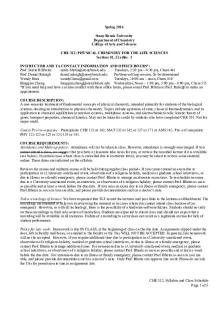Cfssp - pdf PDF

| Title | Cfssp - pdf |
|---|---|
| Author | lawrence verma |
| Course | B.tech |
| Institution | Amity University |
| Pages | 5 |
| File Size | 266 KB |
| File Type | |
| Total Downloads | 34 |
| Total Views | 134 |
Summary
pdf...
Description
Wide Spectrum, Vol. 1, No. 9, (2013) pp 15 - 19
CFSSP: Chou and Fasman Secondary Structure Prediction server T. Ashok Kumar Department of Bioinformatics, Noorul Islam College of Arts and Science, Kumaracoil - 629180, E-Mail: [email protected]
ABSTRACT CFSSP (Chou & Fasman Secondary Structure Prediction Server) is an online protein secondary structure prediction server. This server predicts regions of secondary structure from the protein sequence such as alpha helix, beta sheet, and turns from the amino acid sequence. The output of predicted secondary structure is also displayed in linear sequential graphical view based on the probability of occurrence of alpha helix, beta sheet, and turns. The method implemented in CFSSP is Chou-Fasman algorithm, which is based on analyses of the relative frequencies of each amino acid in alpha helices, beta sheets, and turns based on known protein structures solved with X-ray crystallography. CFSSP is freely accessible via ExPASy server or directly from BioGem tools at http://www.biogem.org/tool/chou-fasman. CFSSP server is written in Perl, which runs through CGI. Key words: CFSSP, ExPASy, BioGem Tools, Secondary Structure, Chou and Fasman. INTRODUCTION Successful prediction of protein structure from the amino acid sequence is one of the challenging tasks in bioinformatics and structural biology; it is highly important in medicine (for example, in drug design) and biotechnology (for example, in the design of novel enzymes). Although experimental structure determination has improved, information about the three dimensional structure is still available for only a small fraction of known proteins. Structure prediction of soluble proteins using experimental methods is still a challenging task due to the vast number of degrees of freedom in the molecule. An intermediate but useful step is to predict the protein secondary structure, that is, each residue of a protein sequence is assigned a conformational state, either helix (H), strand (E) or coil (C). The information provided by this assignment is valuable both in ab initio tertiary structure prediction and as additional restraints for fold recognition algorithms (Cuff and Barton, 2000). In addition, it can also be used in protein function prediction (Paquet et al., 2000). The Chou-Fasman method was among the first secondary structure prediction algorithms developed and relies predominantly on probability parameters determined from relative frequencies of each amino acid's appearance in each type of secondary structure (Chou and Fasman, 1974). The original Chou-Fasman parameters, determined from the small sample of structures solved in the mid-1970s, produce poor results compared to modern methods, though the parameterization has been updated since it was first published. The Chou-Fasman method is roughly 56-60% accurate in predicting secondary structures (Mount, 2004). The evolutionary conservation of secondary structures can be exploited by simultaneously assessing many homologous sequences in a multiple sequence alignment, by - 15 -
T. Ashok Kumar
calculating the net secondary structure propensity of an aligned column of amino acids. In concert with larger databases of known protein structures and modern machine learning methods such as neural networks and support vector machines, these methods can achieve up 80% overall accuracy in globular proteins (Dor and Zhou, 2006). The theoretical upper limit of accuracy is around 90% (Dor and Zhou, 2007), partly due to idiosyncrasies in DSSP assignment near the ends of secondary structures, where local conformations vary under native conditions but may be forced to assume a single conformation in crystals due to packing constraints. Limitations are also imposed by secondary structure prediction's inability to account for tertiary structure; for example, a sequence predicted as a likely helix may still be able to adopt a beta-strand conformation if it is located within a beta-sheet region of the protein and its side chains pack well with their neighbors. Dramatic conformational changes related to the protein's function or environment can also alter local secondary structure. METHODS The algorithm implemented in the CFSSP server is Chou-Fasman algorithm. The ChouFasman method (1985) is a combination of such statistics-based methods and rule-based methods (Chou and Fasman, 1989). Here are the steps of the Chou-Fasman algorithm: Table 1: Conformational Parameters for -Helical, -Sheet, and -Turn Residues in 29 Proteins.a Residue b
P
Glu(-) Met Ala Leu Lys(+) Phe Gln Trp Ile Val Asp(-) His(+) Arg(+) Thr Ser Cys Tyr Asn Pro Gly
1.51 1.45 1.42 1.21 1.16 1.13 1.11 1.08 1.08 1.06 1.01 1.00 0.98 0.83 0.77 0.70 0.69 0.67 0.57 0.57
-Type
H
h
I
i
b B
Residue c
P
Val Ile Tyr Phe Trp Leu Cys Thr Gln Met Arg(+) Asn His(+) Ala Ser Gly Lys(+) Pro Asp (-) Glu (-)
1.70 1.60 1.47 1.38 1.37 1.30 1.19 1.19 1.10 1.05 0.93 0.89 0.87 0.83 0.75 0.75 0.74 0.55 0.54 0.37
a
-Type
H
h
i
b
B
Residue
Pt
Asn Gly Pro Asp(-) Ser Cys Tyr Lys(+) Gln Thr Trp Arg(+) His(+) ( -) Glu Ala Met Phe Leu Val Ile
1.56 1.56 1.52 1.46 1.43 1.19 1.14 1.01 0.98 0.96 0.96 0.95 0.95 0.74 0.66 0.60 0.60 0.59 0.50 0.47
Chou and Fasman (1974) -helix assignments: H (strong former), h ( former), I (weak former), i ( indifferent), b ( breaker), B (strong breaker) c -sheet assignments: H (strong former), h ( former), I (weak former), i ( indifferent), b ( breaker), B (strong breaker). b
- 16 -
CFSSP: Chou and Fasman Secondary Structure Prediction server
i. Search for Helical Regions Any segment of six residues or longer in a native protein with P 1.03 as well as P > P , and satisfying conditions i.a. through i.d., is predicted as helical. a. Helix Nucleation. Scan the peptide and identify regions four helical residues (h, or H ) out of six residues along the polypeptide chain. Weak helical residues (I ,) count as 0.5 h , (i.e., three h and two I residues out of six could also nucleate a helix). Helix formation is unfavorable if the segment contains or more helix breakers (b or B ), or less than ½ helix formers. b. Helix Termination. Extend the helical segment in both directions until terminated by tetrapeptides with P < 1.00. The following helix breakers can stop helix propagation: b4, b3i, b3h, b 2i2, b2ih, b2h2 , bi3, bi2h, bih2, and i4. Once the helix is defined, some of the residues (especially h or i) in the tetrapeptides may be incorporated at the helical ends. The notations i, b, h in the tetrapeptide breakers also include I, B, and H, respectively. Adjacent regions can also terminate regions. c. Pro cannot occur in the inner helix or at the C-terminal helical end. (-)
(-)
(+)
(+)
(+)
d. Helix Boundaries. Pro, Asp , Glu prefer the N-terminal helical end. His , Lys , Arg prefer the C-terminal helical end. I, assignments are given to Pro and Asp (near the N-terminal helix) as well as Arg (near the C-terminal helix) if necessary to satisfy condition i.a. ii. Search for -Sheet Regions Any segment of five residues or longer in a native protein with P 1.05 as well as P > P , and satisfying conditions ii.a. through ii.d., is predicted as sheet. a. -Sheet Nucleation. Scan the peptide and identify regions of three residues (h or H ) out of five residues along the polypeptide chain. -sheet formation is unfavorable if the segment contains or more -sheet breakers (b or B), or less than ½ -sheet formers. b. -Sheet Termination. Extend the sheet in both directions until terminated by tetrapeptides with P < 1.00. Once the sheet is defined, some of the residues (especially h or i) in the tetrapeptides may be incorporated at the helical ends. The notations i, b, h in the tetrapeptide breakers also include I, B, and H, respectively. Adjacent regions can also terminate regions. c. Glut occurs rarely in the region. Pro occurs rarely in the inner region. d. -Sheet Boundaries. Charged residues occur rarely at the N-terminal -sheet end, and infrequently at the inner region and C-terminal end. Trp occurs mostly at the N-terminal -sheet end and rarely at the C-terminal -end. iii. Search for -turn Regions Proline and glycine are both common in turns. A turn is predicted only if the turn probability is greater than the helix or sheet probabilities and a probability value based on the positions of particular amino acids in the turn exceeds a predetermined threshold. After both -helix and -sheet regions have been predicted, the Chou-Fasman algorithm compares the relative probabilities of regions to resolve predictions that overlap. The conformational parameters for coil are not employed; coil is predicted by default. However, in most cases it will
- 17 -
T. Ashok A Kumar
be foundd adequate to o use only thhe former, breaker, b indiifferent assig gnments, an d the termin nation tetrapeptides to locate the seconddary structural regions off proteins. IMPLEM MENTATIO ON T CFSSP web The w server is presented to t the user as a a single page p form. U User can inpu ut the protein sequence in standard fassta file format. The charracters in thee given sequuence are filltered from unk known chara acters and white w spaces. By default, the first linne in the seqquence is read as protein name n and remaining as protein sequ uence. The predicted p seecondary struucture regions of the amino sequence are a represented in graphical and characters as foollows: -hellix ( ), --sheet (E), -turrns (T).
c enteritis viru us. Fig 1: The predicteed secondary structure of protein of Avirulent turkey hemorrhagic
REFERE ENCES G Anaalysis, 2nd eedn. Cold Spring 1. Mounnt,D.M. (20004) Bioinforrmatics: Sequence and Genome Harbor Laboratorry Press, Ne w York. 2. Chou u,P.Y. and Fa asman,G.D. (1974) Prediction of pro otein confor mation. Biocchemistry, 13 (2), 222–245.
- 18 -
CFSSP: Chou and Fasman Secondary Structure Prediction server
3. Dor,O. and Zhou,Y. (2006) Achieving 80% tenfold cross-validated accuracy for secondary structure prediction by large-scale training. Proteins, 66 (4), 838–845. 4. Cuff,J.A. and Barton,G.J. (2000) Application of multiple sequence alignment profiles to improve protein secondary structure prediction. Proteins, 40, 502–511. 5. Paquet,J.Y. et al. (2000) Topology prediction of Brucella abortus Omp2b and Omp2a porins after critical assessment of transmembrane beta strands prediction by several secondary structure prediction methods. J. Biomol. Struct. Dyn., 17, 747–757. 6. Peter Prevelige,Jr. and Fasman,G.D. (1989) Chapter 9: Chou-Fasman Prediction of the Secondary Structure of Proteins: The Chou-Fasman-Prevelige Algorithm. In Fasman,G.D., Prediction of Protein Structure and the Principles of Protein Conformation, Plenum, New York, pp.391-416
- 19 -...
Similar Free PDFs

Cfssp - pdf
- 5 Pages

- 9 Pages

Common Good PDF - pdf
- 7 Pages

- 2 Pages

- 43 Pages

- 47 Pages

- 5 Pages

- 130 Pages

- 16 Pages

Pdf Daniel - pdf
- 223 Pages

Keselamatan_Maritim_2.pdf
- 147 Pages

arens_auditing_14ce_ism_c18.pdf
- 25 Pages

Pdfcoffee - Pdf
- 39 Pages

Τσάμηδες PDF
- 8 Pages
Popular Institutions
- Tinajero National High School - Annex
- Politeknik Caltex Riau
- Yokohama City University
- SGT University
- University of Al-Qadisiyah
- Divine Word College of Vigan
- Techniek College Rotterdam
- Universidade de Santiago
- Universiti Teknologi MARA Cawangan Johor Kampus Pasir Gudang
- Poltekkes Kemenkes Yogyakarta
- Baguio City National High School
- Colegio san marcos
- preparatoria uno
- Centro de Bachillerato Tecnológico Industrial y de Servicios No. 107
- Dalian Maritime University
- Quang Trung Secondary School
- Colegio Tecnológico en Informática
- Corporación Regional de Educación Superior
- Grupo CEDVA
- Dar Al Uloom University
- Centro de Estudios Preuniversitarios de la Universidad Nacional de Ingeniería
- 上智大学
- Aakash International School, Nuna Majara
- San Felipe Neri Catholic School
- Kang Chiao International School - New Taipei City
- Misamis Occidental National High School
- Institución Educativa Escuela Normal Juan Ladrilleros
- Kolehiyo ng Pantukan
- Batanes State College
- Instituto Continental
- Sekolah Menengah Kejuruan Kesehatan Kaltara (Tarakan)
- Colegio de La Inmaculada Concepcion - Cebu

![[PDF] Cours complet marketing en PDF Télécharger PDF](https://pdfedu.com/img/crop/172x258/gwrwp9kme218.jpg)